Categories: Featured Articles » Novice electricians
Number of views: 525960
Comments on the article: 16
What is reactive power and how to deal with it
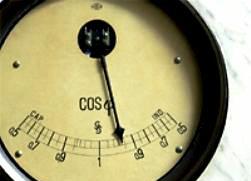 Physics of the process and practice of using reactive power compensation units
Physics of the process and practice of using reactive power compensation units
To understand the concept of reactive power, we recall first what is electric power. Electric power Is a physical quantity characterizing the rate of generation, transmission or consumption of electrical energy per unit time.
The greater the power, the more work the electrical installation can do per unit of time. Measured power in watts (product Volt x Ampere). Instantaneous power is the product of the instantaneous values of voltage and current strength on some part of the electrical circuit.
Process physics
In direct current circuits, the values of instantaneous and average power for a certain period of time coincide, but the concept of reactive power is absent. In AC circuits, this only happens if the load is purely active. This is, for example, an electric heater or an incandescent lamp. With such a load in the AC circuit, the voltage phase and current phase coincide and all the power is transferred to the load.
If the load is inductive (transformers, electric motors), then the current lags in phase from the voltage, if the load is capacitive (various electronic devices), then the current in phase outpaces the voltage. Since the current and voltage do not coincide in phase (reactive load), only part of the power (full power) is transferred to the load (consumer), which could be transferred to the load if the phase shift was zero (active load).
Active and reactive power
The part of the total power that was transferred to the load during the alternating current period is called active power. It is equal to the product current values of voltage and current on the cosine of the phase angle between them (cos φ).
The power that was not transferred to the load, but led to losses in heating and radiation, is called reactive power. It is equal to the product of the current values of current and voltage by the sine of the phase angle between them (sin φ).
Thus, reactive power is a value characterizing the load. It is measured in volt reactive amperes (var, var). In practice, the notion of cosine phi is more often encountered as a quantity characterizing the quality of an electrical installation in terms of energy saving.
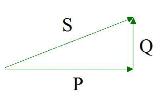
Indeed, the higher the cos φ, the more energy supplied from the source enters the load. So you can use a less powerful source and less energy is wasted.
Reactive power of household consumers
So, AC consumers have such a parameter as the power factor cosφ.
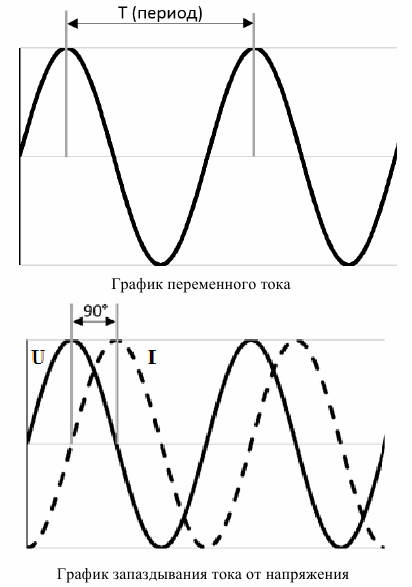
On the graph, the current is shifted 90 ° (for clarity), that is, a quarter of the period. For example, electrical equipment has cosφ = 0.8, which corresponds to an arccos angle of 0.8 ≈ 36.8 °. This shift is due to the presence of non-linear components in the consumer of electricity - capacitors and inductors (for example, windings of electric motors, transformers and electromagnets).
To further understand what is happening, it is necessary to take into account the fact that the higher the power factor (maximum 1), the more efficiently the consumer uses the energy received from the network (that is, more energy is converted into useful work) - this load is called resistive.
With a resistive load, the current in the circuit coincides with the voltage. And with a low power factor, the load is called reactive, that is, part of the power consumption does not do useful work.
The table below shows the classification of consumers by power factor.
AC Consumer Classification

The following table shows the power factor of household electricity consumers.
Power factor of household electrical appliances
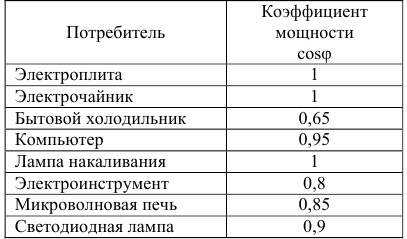
Humor electrician
What is reactive power? Everything is very simple!
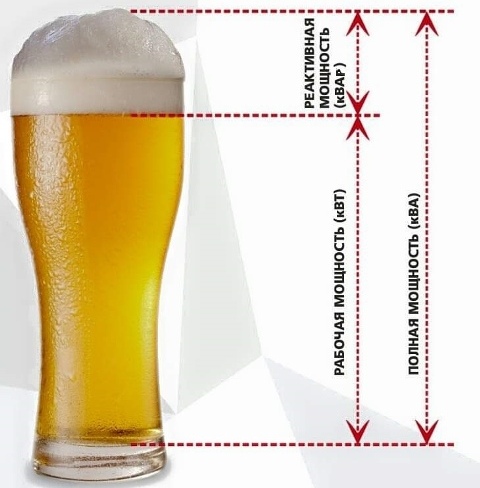
Reactive power compensation methods
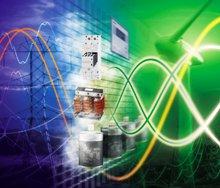 It follows from the above that if the load is inductive, then it should be compensated with the help of capacitors (capacitors) and vice versa the capacitive load is compensated with the help of inductors (chokes and reactors). This helps to increase the cosine phi (cos φ) to acceptable values of 0.7-0.9. This process is called reactive power compensation.
It follows from the above that if the load is inductive, then it should be compensated with the help of capacitors (capacitors) and vice versa the capacitive load is compensated with the help of inductors (chokes and reactors). This helps to increase the cosine phi (cos φ) to acceptable values of 0.7-0.9. This process is called reactive power compensation.
The economic effect of reactive power compensation
The economic effect of introducing reactive power compensation facilities can be very large. According to statistics, it makes up from 12 to 50% of the payment for electricity in various regions of Russia. The installation of reactive power compensation pays off in no more than a year.
For the designed facilities, the introduction of a capacitor unit at the development stage allows saving on the cost of cable lines by reducing their cross-section. An automatic capacitor installation, for example, can raise cos φ from 0.6 to 0.97.
conclusions
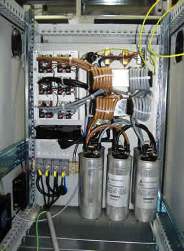 So, reactive power compensation plants bring tangible financial benefits. They also allow you to keep equipment in working condition longer.
So, reactive power compensation plants bring tangible financial benefits. They also allow you to keep equipment in working condition longer.
Here are a few reasons why this happens.
1. Reducing the load on power transformers, increasing in connection with this their service life.
2. Reducing the load on wires and cables, the ability to use cables of smaller cross-section.
3. Improving the quality of electricity from power consumers.
4. Elimination of the possibility of fines for reducing cos φ.
5. Reducing the level of higher harmonics in the network.
6. Decrease in the level of electricity consumption.
See also at e.imadeself.com
:
